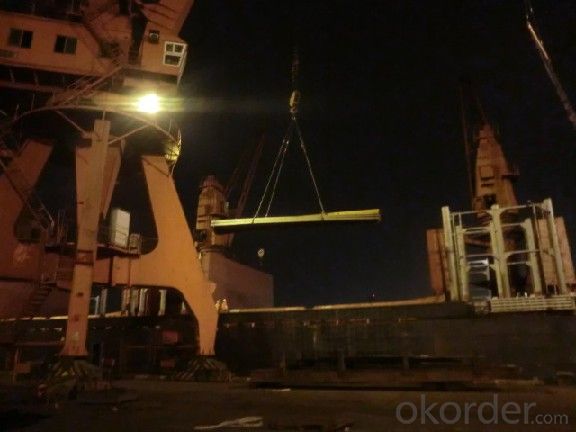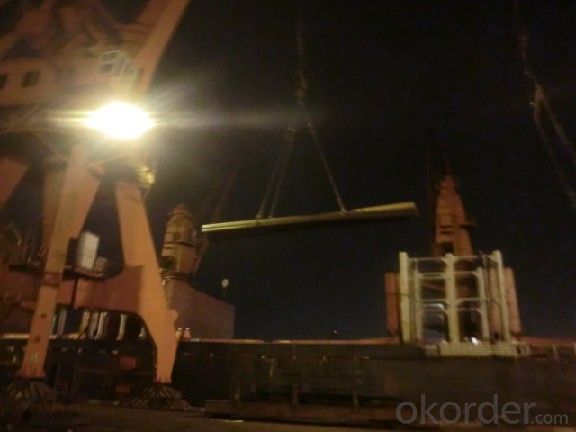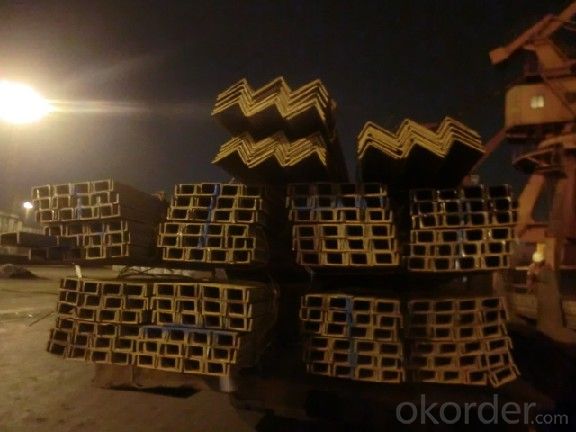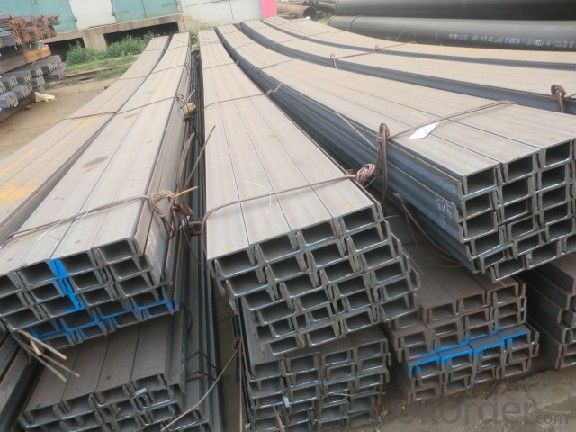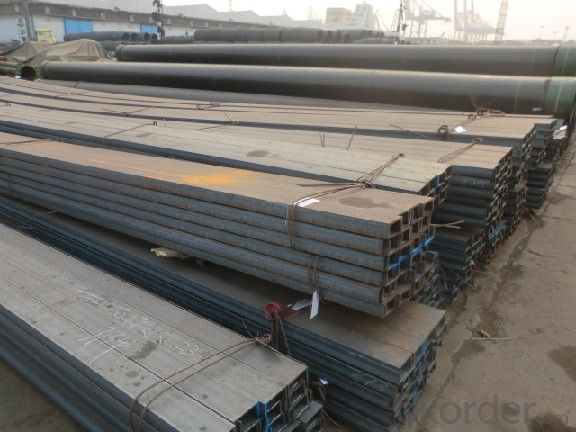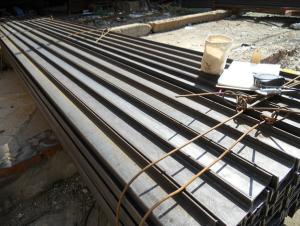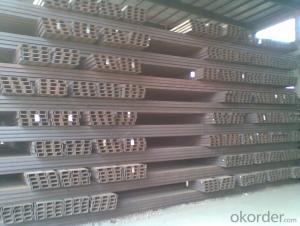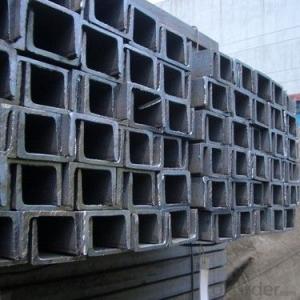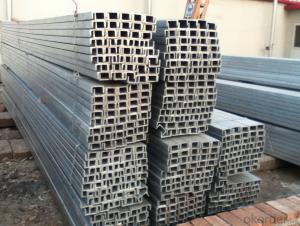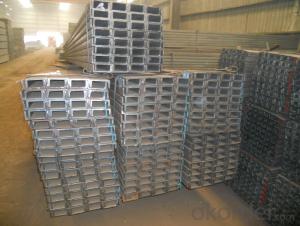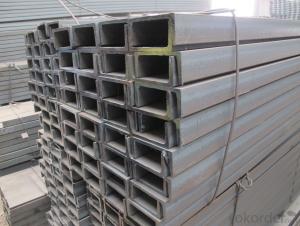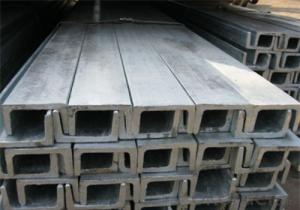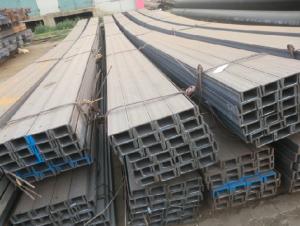high quality low carbon steel channel JIS
- Loading Port:
- Tianjin
- Payment Terms:
- TT OR LC
- Min Order Qty:
- 5 m.t.
- Supply Capability:
- 1000 m.t./month
OKorder Service Pledge
OKorder Financial Service
You Might Also Like
Product Description:
Specifications of MS Channel:
1.We supply high quality MS Channel at reasonable price, including Chinese standard, Japanese standard and so on.
Standard | GB/JIS |
Material Grade | Q235,SS400 |
Technique: | Hot Rolled |
Sizes as per chinese standard: | 50*37*4.5mm - 300*89*11.5mm |
Sizes as per japanese standard: | 50*25*3mm – 200*80*7.5mm |
Length: | 6meter, 9meter, 12meter |
Note: 1.we are also competent to provide our customers other MS Channel based on other sizes according to customer’s requirements.
2. The length of our ms channel could be cut into other meters as per customer’s requirements. For example, the channel in 6meters could be cut into 5.8meters in order to be fit in the 20ft container.
2. The detailed sections of MS Channel as per GB standard.are shown in the table-1:
GB U CHANNEL | Standard | Sectional | Dimension |
| Mass: |
| (mm) | (mm) | (mm) | (mm) |
|
50X37 | 50 | 37 | 4.50 | 7.0 | 5.438 |
63X40 | 63 | 40 | 4.80 | 7.5 | 6.634 |
80x43 | 80 | 43 | 5.00 | 8.0 | 8.045 |
|
|
|
|
|
|
100x48 | 100 | 48 | 5.30 | 8.5 | 10.007 |
120x53 | 120 | 53 | 5.50 | 9.0 | 12.059 |
140x58 | 140 | 58 | 6.00 | 9.5 | 14.535 |
140x60 | 140 | 60 | 8.00 | 9.5 | 16.733 |
|
|
|
|
|
|
160x63 | 160 | 63 | 6.50 | 10.0 | 17.240 |
160x65 | 160 | 65 | 8.50 | 10.0 | 19.752 |
|
|
|
|
|
|
180x68 | 180 | 68 | 7.00 | 10.5 | 20.174 |
180x70 | 180 | 70 | 9.00 | 10.5 | 23.000 |
|
|
|
|
|
|
200x73 | 200 | 73 | 7.00 | 11.0 | 22.637 |
200x75 | 200 | 75 | 9.00 | 11.0 | 25.777 |
|
|
|
|
|
|
220x77 | 220 | 77 | 7.00 | 11.5 | 24.999 |
220x79 | 220 | 79 | 9.00 | 11.5 | 28.453 |
|
|
|
|
|
|
250x78 | 250 | 78 | 7.00 | 12.0 | 27.410 |
250x80 | 250 | 80 | 9.00 | 12.0 | 31.335 |
250x82 | 250 | 82 | 11.00 | 12.0 | 35.260 |
|
|
|
|
| |
280x82 | 280 | 82 | 7.50 | 12.5 | 31.427 |
280x84 | 280 | 84 | 9.50 | 12.5 | 35.823 |
280x86 | 280 | 86 | 11.50 | 12.5 | 40.219 |
|
|
|
|
|
|
300x85 | 300 | 85 | 7.50 | 13.5 | 34.463 |
300x87 | 300 | 87 | 9.50 | 13.5 | 39.173 |
300x89 | 300 | 89 | 11.50 | 13.5 | 43.883 |
Table-1
3. The chemical composition of HR Channel Steel according to Q235B is shown in Table-2.
Alloy No | Grade | Element(%) | ||||
C | Mn | S | P | Si | ||
Q235 | B | 0.12-0.20 | 0.3-0.7 | ≦0.045 | ≦0.045 | ≦0.3 |
Table-2
Note: we are able to present our customers relevant SGS test report for chemical composition of HR Channel Steel.
4. The mechanical property of HR Channel Steel according to Q235B is shown in Table-3-1 and Table-3-2
Alloy No | Grade | Yielding Strength Point(Mpa) | |||
Thickness(mm) | |||||
≦16 | >16-40 | >40-60 | >60-100 | ||
≧ | |||||
Q235 | B | 235 | 225 | 215 | 205 |
Table-3-1
Alloy No | Grade | Tensile Strength(Mpa) | Elongation After Fracture(%) | |||
Thickness(mm) | ||||||
≦16 | >16-40 | >40-60 | >60-100 | |||
≧ | ||||||
G235 | B | 375-500 | 26 | 25 | 24 | 23 |
Table-3-2
Note: we are able to present our customers relevant SGS test report for mechanical property of MS Channel as customer’s request.
Applications of MS Channel:
The MS Channel can be applied to construction of warehouses, workshops, sport stadiums and car parks etc.The hot rolled channel steel belongs to carbon structural steel which is applied to in the field of construction and machinery.In details, the hot rolled channel steel is usually used for arch-itechtural structure, and they could be welded in order to support or hang a vari-ety of facilities. They are also usually used in combination with I beam. Generally,the hot rolled channel steel we supply must possess perfect welding property, riveting property and mechanical property and so on.
Package & Delivery of MS Channel:
1.The hot rolled channel steel will be packed in bundle with steel wire at each end of every bundle and color marking in order to help the customer to recognize his goods more easily at sight.
2. And the hot rolled channel steel could be loaded into 20ft or 40ft container, or by bulk cargo.If the weight of each bundle reaches more than 3.5 mt, the loading by break bulk cargo should be choosed.When the weight of each bundle reaches less than 3mt, the loading by container should be choosed.
3.As for the transportaion from mill to loading port, the truck will be usually used. And the maximum quantity for each truck is 40mt.
4.All in all, we could do in accordance with customer's request
- Q: Are steel channels suitable for seismic zones?
- Yes, steel channels are suitable for seismic zones. Steel is a strong and ductile material that can effectively resist seismic forces. Steel channels are commonly used in seismic design and construction due to their ability to provide structural stability and resilience during earthquakes. They offer excellent strength-to-weight ratio, flexibility, and resistance to bending and shearing forces, making them a reliable choice for seismic zone applications.
- Q: Do you have any width 20 cm wide? What's the model number and how much is it?
- Channel steel has three sizes: height, leg width and waist thickness.
- Q: What are the different types of connections used for steel channels in curtain wall systems?
- Steel channels in curtain wall systems can be connected using various methods to ensure structural integrity and performance. The following are some commonly used connection types: 1. Welded Connections: Steel channels are joined together by welding, providing excellent strength and rigidity. This type of connection is ideal for high-rise buildings or structures requiring maximum load-bearing capacity. 2. Bolted Connections: Bolts and nuts are used to secure the steel channels, allowing for easy installation and disassembly. This flexibility makes bolted connections suitable for situations requiring frequent adjustments or modifications. 3. Clamped Connections: Clamps or brackets hold the steel channels in place, enabling quick installation without drilling or welding. Clamped connections are convenient for temporary structures or buildings with frequent changes. 4. Adhesive Connections: High-strength adhesives or epoxy bond the steel channels, providing excellent load transfer and even stress distribution. Adhesive connections are used in curtain wall systems where a seamless appearance or aesthetics are a priority. 5. Combination Connections: Sometimes, a combination of different connection types is used to achieve optimal performance. For instance, a curtain wall system may employ both welded and bolted connections to provide strength and flexibility. Combination connections are common in complex or specialized curtain wall systems with specific load-bearing requirements. It is important to consider factors such as structural requirements, building codes, design considerations, and installation constraints when selecting a connection type. Consulting with a structural engineer or curtain wall specialist is crucial for determining the most suitable connection type for a specific curtain wall system.
- Q: Can the bypass of the overhanging layer on the site be made of channel steel? How can I put the channel steel, if possible?
- The cantilever end of 6.10.7 steel cantilever beam shall be provided with a fixed point which can make the scaffold stand firmly with the steel beam. The location shall be no less than 100mm at the end of the cantilever beam. When the 6.10.8 anchor position is set on the floor slab, the thickness of the slab shall not be less than 120mm.
- Q: 24 meters long, 4 meters per column, 6 meters wide. How large channel steel should be used to make the beam?
- The channel should not be used as bearing beam, 6 meters 4 meters across the Bay 14~16 I-steel beam available 1.2~1.5 m spacing C or Z shape.
- Q: What are the common applications of steel channels?
- Steel channels, also known as C-channels or U-channels, are versatile structural components that find numerous applications across various industries. Here are some common applications of steel channels: 1. Construction industry: Steel channels are extensively used in the construction industry for structural support and framing purposes. They provide strength and stability to buildings, bridges, and other structures. Steel channels are often used as beams, columns, and purlins to distribute weight and resist deformation. 2. Building facades: Steel channels are utilized in building facades to create decorative and functional elements. They can be used as curtain wall frames, window frames, and cladding supports. Steel channels provide durability, weather resistance, and a sleek aesthetic to the building exteriors. 3. Manufacturing and industrial applications: Steel channels are widely employed in manufacturing and industrial settings for various equipment and machinery. They are used as support structures for conveyor systems, racks, shelves, and platforms. Steel channels offer high load-bearing capacity and can withstand heavy loads, making them suitable for industrial applications. 4. Electrical installations: Steel channels are commonly used in electrical installations to provide support and protection for electrical cables and wiring. They are used as cable trays, raceways, and support systems for electrical equipment. Steel channels ensure organized and secure routing of electrical cables, preventing damage and reducing the risk of electrical hazards. 5. Automotive industry: Steel channels are utilized in the automotive industry for various applications. They are used in the construction of vehicle frames, chassis, and suspension systems. Steel channels provide strength, rigidity, and impact resistance, ensuring the structural integrity and safety of automobiles. 6. Infrastructure projects: Steel channels are crucial components in infrastructure projects such as bridges, highways, and railways. They are used in the construction of bridge beams, guardrails, and noise barriers. Steel channels offer excellent load-bearing capabilities and durability, making them suitable for heavy-duty infrastructure applications. 7. Furniture and interior design: Steel channels are used in the manufacturing of furniture and interior design elements. They can be incorporated into tables, chairs, shelves, and cabinets to provide structural support and enhance aesthetics. Steel channels offer a modern and industrial look, making them a popular choice in contemporary furniture and interior design. Overall, steel channels are versatile components that find extensive applications in construction, manufacturing, electrical installations, automotive, infrastructure, and furniture industries. Their strength, durability, and adaptability make them an essential choice in various structural and functional applications.
- Q: I want to know what kind of steel is this type of steel, such as channel steel and die steel?
- Belong to section bar. In accordance with the different smelting quality of steel, steel is divided into ordinary steel and high quality steel. According to the current catalogue of metal products, ordinary steel can be divided into large section steel, medium section steel and small section steel. The section steel can be divided into I-beam, channel steel, angle steel, round steel and so on according to its sectional shape. Large steel: large steel, I-beam, channel steel, angle steel and flat steel are hot rolled, round bar, Fang Gang, six angle iron in addition to hot rolling, there are forging, cold drawn and so on.
- Q: What are the different methods of surface treatment for steel channels?
- There are several different methods of surface treatment for steel channels, each offering unique benefits and characteristics. Some of the commonly used methods are: 1. Hot-dip galvanizing: This method involves immersing the steel channels in a bath of molten zinc. The zinc coating provides excellent corrosion resistance and protects the steel from rust and other environmental factors. It is a popular choice for outdoor applications where long-term durability is required. 2. Powder coating: Powder coating is a dry finishing process in which a powdered polymer is electrostatically applied to the steel channels and then cured under heat. This method provides a durable and attractive finish, with a wide range of colors and textures available. Powder coating also offers excellent resistance to chipping, scratching, and fading. 3. Electroplating: Electroplating involves depositing a thin layer of metal, such as chromium or nickel, onto the surface of the steel channels through an electrochemical process. This method enhances the corrosion resistance and improves the appearance of the channels. Electroplating can also increase the hardness and wear resistance of the steel. 4. Paint coating: Paint coating is a common method where a layer of paint is applied to the surface of the steel channels. This method provides a decorative finish and also protects the steel from corrosion and weathering. Different types of paints, such as epoxy, acrylic, or polyurethane, can be used based on the specific requirements of the application. 5. Anodizing: Anodizing is primarily used for aluminum, but it can also be applied to steel channels. This process involves creating an oxide layer on the surface of the metal through an electrochemical reaction. Anodizing improves the corrosion resistance, provides a decorative finish, and can also enhance the wear resistance of the steel. 6. Phosphating: Phosphating is a chemical process that involves applying a phosphate coating to the surface of the steel channels. This method improves the adhesion of paint or other coatings, provides a protective layer against corrosion, and can also enhance the lubricity of the steel. Each method of surface treatment for steel channels has its own advantages and is suitable for different applications. The choice of the treatment method depends on factors such as the intended use of the channels, the environmental conditions, and the desired appearance and performance characteristics.
- Q: Industrial plant pipe hanger expansion bolts, why add a section of channel, and then connect the screw rod?. The outer expansion bolt of the embedded beam is connected with a section of channel steel, and then the steel bar is hung under the channel steel. Why do you want to do this? What are the advantages?
- Outside the first expansion bolt connected with a section of steel, steel hanging wire hanger form following bar is now commonly used in the expansion and harness
Send your message to us
high quality low carbon steel channel JIS
- Loading Port:
- Tianjin
- Payment Terms:
- TT OR LC
- Min Order Qty:
- 5 m.t.
- Supply Capability:
- 1000 m.t./month
OKorder Service Pledge
OKorder Financial Service
Similar products
Hot products
Hot Searches
Related keywords





